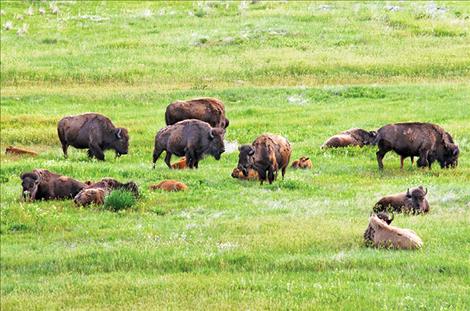Comprehensive Conservation Plan process begins at Nat’l Bison Range
Hey savvy news reader! Thanks for choosing local.
You are now reading
1 of 3 free articles.
POLSON – The U.S. Fish and Wildlife Service has begun the process for creating a Comprehensive Conservation Plan for the National Bison Range and other conservation lands in Lake and Flathead counties.
The initial public meeting was held Tuesday, June 6, at the Red Lion in Polson. Another was held June 7 in Kalispell.
About a dozen members of the public attended the Polson event along with a number of FWS employees and Lake County Commissioners Dave Stipe and Gale Decker.
Toni Griffin, a FWS refuge planner from Denver, said the effort is the beginning of a three-year process.
At question is whether the CCP process will include an annual funding agreement between the FWS and the Confederated Salish and Kootenai Tribes. Two previous annual funding agreements, which involved the tribes in management of the bison range, ended in 2006 and 2009. (Secretary of the Interior Ryan Zinke recently nixed a transfer of the range to the Confederated Salish and Kootenai Tribes that was proposed during the Obama administration.)
According to a letter from former FWS Director H. Dale Hall in which he referred to “concerns about tribal employee and leadership behavior,” the federal agency terminated an annual funding agreement with CSKT after 18 months in December 2006.
Griffin said the second annual funding agreement ended as the result of a lawsuit related to implementation of the National Environmental Policy Act.
Bernie Petersen, a FWS refuge supervisor from Denver, said an annual funding agreement for management of the National Bison Range may be one of the alternatives proposed. However, any negotiations with the tribes would follow after a CCP is finalized, he said.
Missoula resident Susan Reneau, one of a number of people involved in a current lawsuit against the FWS that charges the federal agency with failing to complete a CCP for the bison range within the statutorily mandated 15 years, said she’d like to see only federal employees at the site and no tribal or “special interest” employees.
Jeff King, project leader at the National Bison Range, said there are four maintenance employees at the range in addition to himself.
‘Gorilla’ in the room
Phil Barney, a Polson resident and representative of Protect Public Land, said the gorilla in the room is the personnel issue, which he said has been dogging the bison range for a number of years because of the uncertainty about its future.
Skip Palmer, who said he worked at the bison range for 16 years and the FWS for 22, said both the federal agency and the tribes were at fault in previous years.
“They forgot what the mission was and let politics get involved,” he said.
Palmer said the bison range hasn’t been getting enough funding and added that there is very little money for weed control at Ninepipe Wildlife Refuge, which is also included in the three-year CCP planning process, although it’s under a separate track from the Bison Range. He said that white top, an invasive weed, is on both sides of the irrigation canal at Ninepipe and consequently spreads to the farms served by the canal.
Barney said he wants the bison range to be expanded for use similarly to that of a national park with an entrance created at the top of Ravalli Hill.
According to the FWS website, a CCP is a plan that identifies goals to guide the management of each refuge or district for the next 15 years. Each plan has detailed objectives and strategies that the FWS will carry out to achieve identified goals.
One CCP and environmental impact statement will be developed for the National Bison Range and another for Ninepipe, Pablo, and Lost Trail national wildlife refuges and wetland/waterfowl management districts in Lake and Flathead counties. Lake County has nine such properties in the latter designation and Flathead County five, including the 2,600-acre Flathead Waterfowl Production Area that is located along Flathead Lake’s northern shore.
Not just bison
The 18,766-acre National Bison Range is not just for bison, Griffin said, noting President Theodore Roosevelt created it in 1908, but Congress added bird habitat to its purposes in 1921. The bison range has over 200 species of migratory birds that frequent the site.
The bison range was the FWS’ 10th most visited site in 2013 with some 200,000 visitors, King said, adding that it created some $13 million in gross revenue that year along with 169 jobs in the local community.
That revenue, i.e. including tourist dollars, is why Lake County is at the table, deputy county attorney Wally Congdon said prior to last week’s meeting. He said Lake County gets some $30,000 a year in Payment In Lieu of Taxes (PILT) revenue from the federal government as a result of the bison range.
The public can make comments about the CCP by emailing: scoping_NBR@fws.gov for the bison range or scoping_pablo_ninepipe@fws.gov for the other properties.
For more information, go online at www.fws.gov/mountain-prairie/refuges/nbrc.php or call 406-644-2211.
















